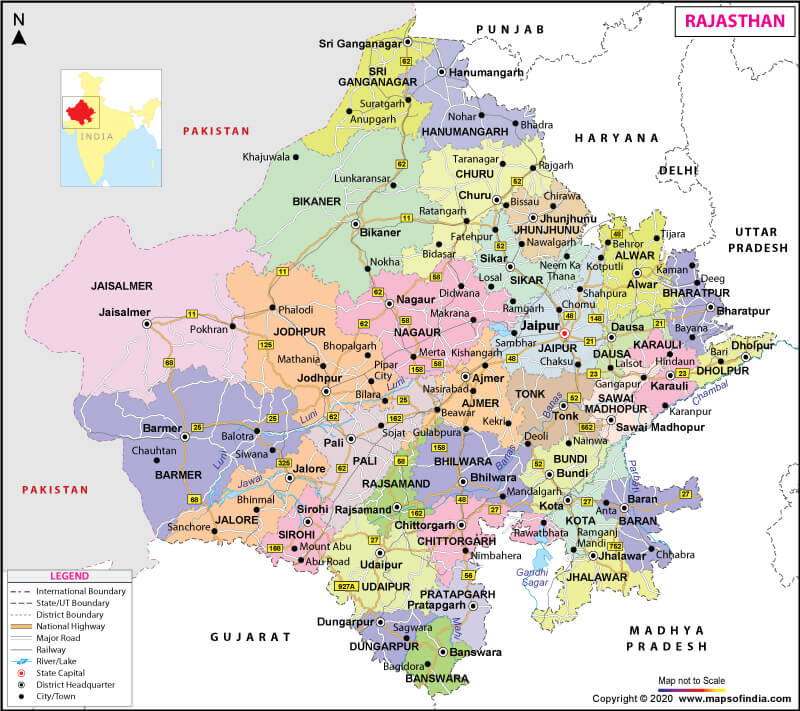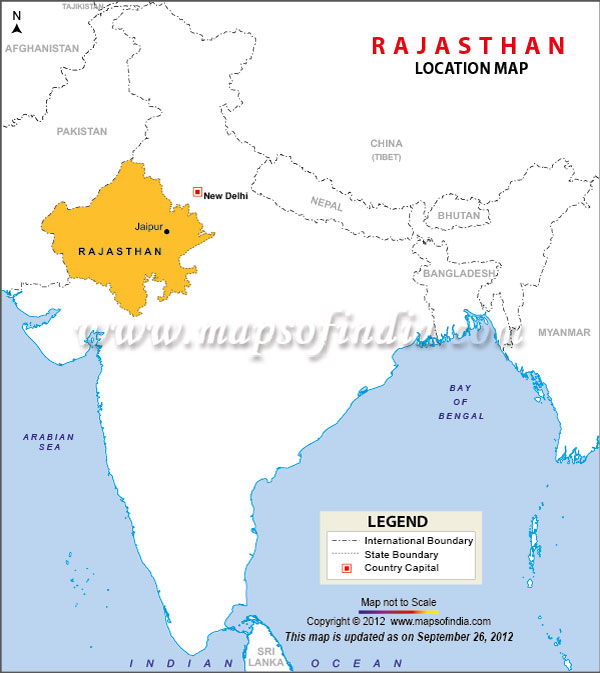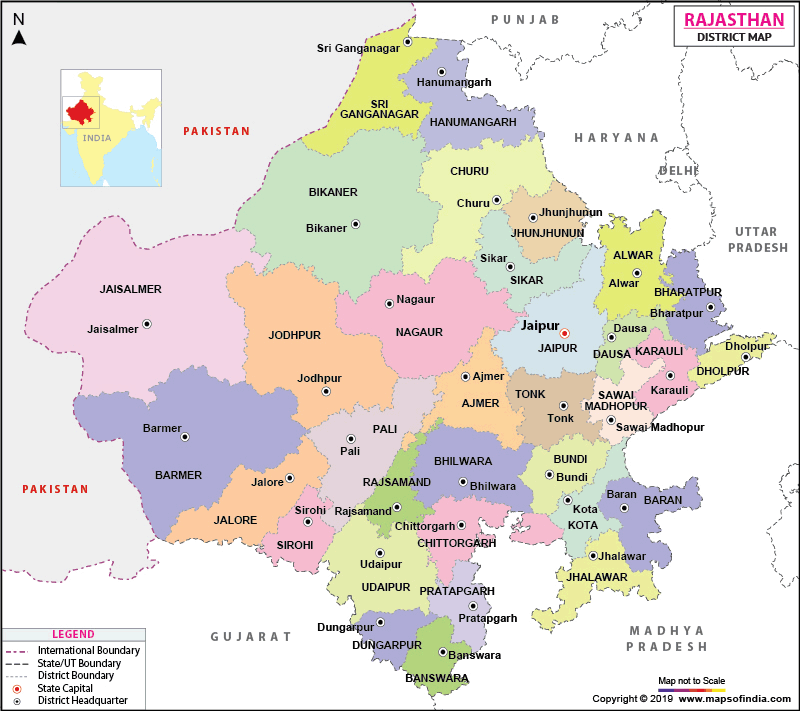

Where is Rajasthan?
Rajasthan is situated in the northwestern part of India. It came into existence as a new state on March 30, 1949. Punjab surrounds Rajasthan to the north and Haryana to the northeast. It is also bounded on the east by Uttar Pradesh, Madhya Pradesh to the southeast, and Gujarat to the southwest. Rajasthan also shares its border with the Pakistani provinces of Punjab and Sindh to the northwest and west, respectively, along the Sutlej-Indus river valley. Estimation is that around 61 percent area of the Thar desert lies in Rajasthan. Jaipur is the capital of Rajasthan, also known as the Pink City.
What is the Geography of Rajasthan?
The state spreads across a total area of 342,239 sq. km (132,139 sq. mi). Rajasthan is the biggest state of the country in terms of area. The population of Rajasthan in 2019 was 81,032,689, and the density of the population was 200 per sq. km (as per 2011 census).
The state lies between 23°3′ to 30°12′ to North latitude and 69°30′ to 78°17′ East longitude. Geographically, Rajasthan is dominated by the Thar Desert and the Aravalli Range, which occupies a large part of the state from southwest to northeast. The Thar desert lies in the northwestern area of Rajasthan.
The Aravalli Range creates a line across the state running from Guru Shikhar (Mount Abu), which is 5,650 feet (1,722 meters) in height, which lies to Khetri (a small town) in the northeast. The Aravalli range divides Rajasthan into two parts 60 percent in the northwest of the range while 40 percent lies in the southeast.
There are two main rivers of Rajasthan. Chambal and Luni. Chambal is the only perennial stream of the state. The main tributary of the Chambal river is the Banas River, which rises in the Aravallis near the Kumbhalgarh hill fort. The Luni is the only important river of the west of the Aravallis, rises near Ajmer, and it flows about (320 km) west-southwest into the Rann of Kachchh in Gujarat. Sambhar Salt Lake is in the northeast of the Luni basin. Luni dries up in the summer season, so it is called a seasonal river. It gets water from the drainage of the southwest slopes of the Aravalli Range.
According to the Forest Survey of India and the State of Forest report in 2019, the total forest area of the state is about 32,737 square km. An estimation is that around 9.57 percent area of the state is covered by forest and about 4.28 percent of the country’s total forest area.
The main species of such kinds of forests are Acacia leucophloea, Prosopis cineraria, Capparis aphylla, Ziziphus spp, Acacia nilotica, Flacourtia spp and so on. Dense forest areas of Rajasthan are found in the western part of the state, such as Jalore, Churu, Bikaner, Nagaur, etc.
There are several kinds of soil available in Rajasthan. Sandy soil is found in abundance in the state. This soil does not store much water. Apart from this clay, loamy, black lava soil, alluvial soil, and nitrogenous soils are also found in the state.
The state is home to tigers and several endangered animals. Leopards are also spotted in some forests of Rajasthan. Besides, dogs, asses, goats are also found in Rajasthan. The state is home to about 500 birds, and over 100 migratory birds arrive in the state during the winter season. Siberian cranes, Greater Flamingo, Black Winged Stilt, and many more migratory birds, etc., are spotted in the state. Peacock, Pigeons, Doves, Mynas, Sparrows, Crows, Koels, Partridges, Parrots, Babblers, Tailor Birds, etc. can be seen in Rajasthan.
Camel and Chinkara are the state animal, while the Great Indian Bustard is the symbol of the state bird. Apart from this Tecomella is the state flower while Jand marks as the state tree.
What is the Climate of Rajasthan?
Rajasthan is known for its tropical desert climate. The climate of Rajasthan keeps changing in the whole state. The desert region of the state is hot and dry in summer and becomes cold during the winter season. Rajasthan experiences low rainfall: therefore, drought and the crisis of water always arise in the state. Day temperature during summer in the state is very high, and it varies between 32 degrees Celsius and 49 degrees Celsius. But the summer night is comfortable. The night temperature ranges somewhere between 20°C to 29°C.
January is the coldest month in Rajasthan. The temperature of some places such as Churu, Sikar, Pilani and Bikaner dip to -2°C at night, during winter. Usually, the winter temperature remains from 4 Degree Celsius to 28 Degree Celsius.
What is the Economy of Rajasthan?
Rajasthan’s economy is based on agriculture and pastoral. The state is the primary producer of wheat and barley. Sugarcane and oilseeds are also cultivated in the state. Two crops of the state cotton and tobacco are the cash crops. At present, Rajasthan is the biggest wool-producing state in the country. The irrigation in the state takes place from wells and tanks. The Indira Gandhi Canal has proved a boon for the northwestern Rajasthan. The state produces 11 percent of the total milk production in the country. It is on the second spot after Uttar Pradesh.
Rajasthan is famous for industries such as textile, rugs, woolen goods, vegetable oil, and dyes. Also, the state is known for several heavy industries like copper and zinc smelting and the manufacture of railway rolling stock.
The Rajasthan government has been developing many SEZs in the state for the promotion in several sectors like gems and jewelry, IT, electronics, textiles, and so on.
What is the Transportation System of Rajasthan?
Rajasthan is well-connected with the entire country by road, rail, and air. The state government’s bus services network is immense. Rajasthan State Road Transport Corporation works under the state government. Private bus services are available in Rajasthan as well.
The state is well-connected by the Indian Railways. All essential and big cities are linked with almost all parts of the country.
Jaipur is the only international airport in the state. Jodhpur and Udaipur also have airports while Jaisalmer airport is operated from October to March.
What are the Popular Tourist Attractions in Rajasthan?
Rajasthan is a paradise for tourists. Rajasthan has some historical buildings such as- Amber Fort, Chittorgarh Fort, Sonar Quila. Hawa Mahal, Jal Mahal, and many more. Apart from natural beauties, Ranthambore National Park, Mount Abu Wildlife Sanctuary, Desert National Park, Sambhar Lake Wildlife Sanctuary, and many more are the places that are worth seeing in Rajasthan.
Related Maps:



